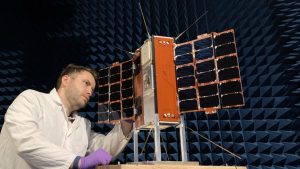British Launch Vehicles 2024: Who Will Send Rockets Into Space?
9th Feb 2024
The UK is emerging from its space launch dark age and is finally ready to demonstrate British launch vehicles in 2024.
In 1971 the British-made Black Arrow rocket placed a probe called Prospero into orbit. Following a decade of Britain pushing hard to build launch capabilities, the programme was cancelled within a year. More than half a century would pass until a British launch would be attempted again.
Now, in the 2020s, it is largely private companies taking on the task of sending rockets into space. Instead of launching in the Aussie outback like the Black Arrow, these companies are also aiming to launch British launch vehicles from the sites being created in the Shetlands as well as Sutherland and Newquay.
In fact, Skyrora does consciously harken back to the space programme of the 60s and 70s, as a band of damaged metal sits in the entrance of their manufacturing centre in Cumbernauld, Scotland. That piece of metal, from the Black Arrow project, sat in the Australian wilderness for 50 years along with the hopes of British launch until a few private companies took on the baton.
Below, we provide a full rundown of where British launch vehicles are at this moment in time.
| Company | Associated Launch site | Estimated launch year |
| Skyrora | SaxaVord | 2024 |
| Orbex | Sutherland Spaceport | Unknown |
| SmallSpark | Unknown | 2024 |
| HyImpulse | SaxaVord | 2024 |
| Astraius | Prestwick Spaceport | 2024 |
Skyrora
Backed by both the UKSA and the ESA, Skyrora is developing its XL Launcher from their Shetland base, SaxaVord, at Unst.
Driven by the fact that modern electronics are much smaller (satellites can be as small as a shoebox), Skyrora XL is a relatively compact 22 metres in height. The latest tech makes the XL possible, as it will feature engines largely made out of 3D-printed components.
The craft is designed to take payloads into Sun-Synchronous Orbit (SSO) between a range of 500km and 1,000km in altitude. Alternatively, it will be able to place payloads into Polar Orbit between a range of 200km and 1,000km in altitude.
It is driven by Skyforce and LEO engines, and shares 70% of its technology with the Skylark L craft which the company attempted to launch in 2022. The Skylark L “experienced an anomaly” after leaving the launch pad and landed in the sea, just 500 meters away from the launch site.
COO Lee Rosen explained that the launch gave the team “valuable experience in operations procedures, logistics coordination, and execution of the rapid setup and pack-down of our mobile launch complex, experience which will propel us forward monumentally in our mission to reach orbit.”
The XL is now the main focus of Skyrora, and Euan Clark, a project team lead at Skyrora, recently spoke to the Observer regarding the ambitious goals of the craft, which will launch from Unst and is ideally situated for North Sea monitoring.
“We expect that environment-monitoring probes, as well as communication satellites, will form the core of our business,” Clark said. “Each rocket will be able to carry payloads up to 300kg, at a cost of £30,000 to £36,000 per kilogram, burning 50,000 litres of fuel to take their cargoes to heights of 1,000km.”
“In a few years, we hope to launch a rocket every month,” continued Clark. “There are seven engines on the Skyrora first stage and another in its second stage, which means we will have to build one of them every three or four days to keep up that schedule.”
The engines driving the launch vehicles use a kerosene-peroxide propellent, that can be stored in a launchpad even if there are delays, this is not possible with liquid-oxygen-based fuels.
Though the Skyrora XL was originally slated for launch in 2023, a 2024 test flight does appear to be in the offing.
HyImpulse
HyImpulse is a company with German roots also aiming to create a powerful launch vehicle in the UK, and their recent government grant will assist them in their mission to make a Shetland-based motor test programme to implement design improvements for an advanced hybrid rocket, which will power the company’s sub-orbital and orbital launch vehicles. HyImpulse has long been using the site for motor testing.
On 28th July 2023, the United Kingdom’s UK Civil Aviation Authority (CAA) granted HyImpulse permission to launch its SR75 rocket from SaxaVord between 1st December 2023 and 30th November 2024. Even though SaxaVord doesn’t yet have a full spaceport licence, the CAA will allow the suborbital flight as its maximum altitude will be 47 kilometres, and given its relatively modest engine size. However, this launch is now likely to happen in Australia, with further launches still slated for Scotland.
Orbex
Another company throwing its hat into the launch vehicle ring is Orbex. The Orbex Prime was unveiled in 2022, but is still awaiting its first flight. Originally expected in 2023, this could take longer due to the fact that the Orbex team have also taken on the development at Sutherland Spaceport and a 50-year lease on the port. Moreover, a change at the helm, with the April 2023 departure of founding CEO Chris Larmour in April uncovered a lack of progress. Martin Coates, who has been involved with Orbex since the beginning, has taken over. However, little technical advancement has been announced since then.
Orbex Prime
Orbex’s Prime aims to become one of the leaders among British launch vehicles. This craft may be a micro-launcher, meaning it only has a capability of launching up to 180kgb. Its compact size of 19m x 1.45m, and the fact that it will be reusable, shows how the industry has changed.
The launch vehicle uses low-carbon fuels. The bio-propane it burns cuts carbon emissions by 90% in comparison to hydrocarbons. On top of that, they have managed to reduce the inert mass by around 30% and increase efficiency by one-fifth in the process.
Like Skyrora, they are also making use of 3D printing for the engine, meaning fewer joins. The vehicle also uses Orbex’s flight-proven guidance, navigation and control (GNC) algorithms.
More Launch Vehicles In the Works
This won’t be the last of the launch vehicles. In fact, companies including SmallSpark Space Systems, and Newton Launch Systems are all working on their own vehicles. The UK has five different space launch facilities in development and is going to need launch vehicles to hit the targets it has for vertical launch.
SmallSpark
SmallSpark Space Systems in Cardiff was recently awarded a government grant to help with the “development and maturation of SmallSpark’s dual-firing mode propulsion system, the S4-NEWT-A2; which will form part of the architecture of its S4-SLV in-space logistics vehicle, and as a candidate system for upper-stage launch vehicles.”
SmallSparks S4-Space Logistic Vehicle (S4-SLV) is scheduled for a first mission in 2024. This will be a three phase mission with the goal of reaching a low lunar orbit. SLV aims to provide “deep-space transportation capabilities for low-mass satellites; eliminating the need for dedicated onboard power, communication and transport for up to 6 * 1U payloads.”
A demo mission could take place as early as 2024 and spaces are available to book on the craft now.
Astraius
The Astraius launch vehicle makes use of horizontal launch, which has successfully delivered many satellites to orbit over decades. The vehicle will be able to launch payloads of up to 800kg using an air-launch programme that uses a C-17 Globemaster transport aircraft. Unlike Virgin Orbit, which used a former passenger version of the Boeing 747 with the rocket hauled under-wing, the Astraius C-17 will carry the rocket internally, and slide it out at the proper altitude. The rocket is stabilised with a series of chutes, before being propelled upwards into orbit by a thruster.
There is no denying that in terms of vertical launch, Skyrora and HyImpulse are far ahead of the competition, but for the sake of the industry, the UK will be hoping that these companies are trailblazers that will be joined by other commercial enterprises, supported by both the ESA and UKSA as Britain establishes itself as a regular launch site for satellites and other payloads.






Thank you for your comment! It will be visible on the site after moderation.